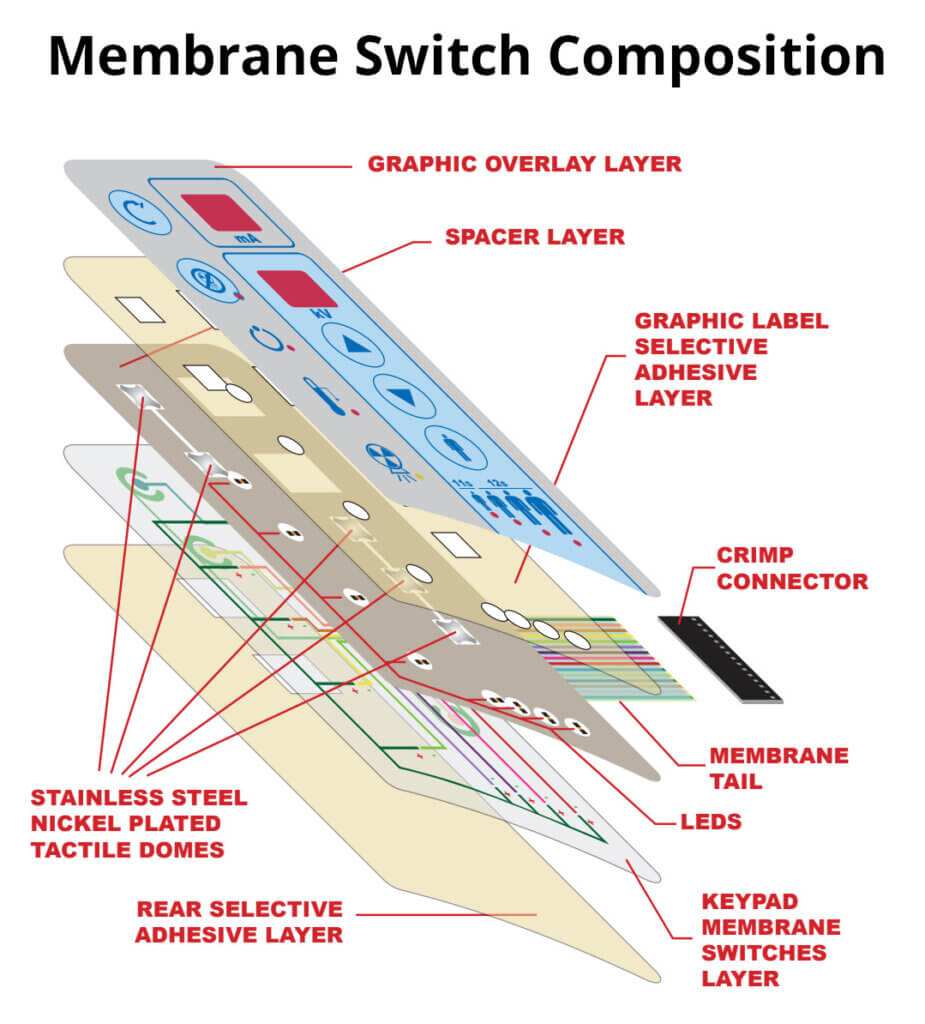Understanding Membrane Layer Switches: The Secret to Trustworthy and resilient Controls

What Are Membrane Layer Switches?
Membrane switches are an advanced remedy in the world of customer interface technology, incorporating capability and design perfectly. These gadgets act as a user interface in between customers and digital systems, incorporating several parts into a compact format. Usually built from versatile, slim layers of materials, membrane layer buttons are made to react to touch, enabling users to connect with machinery and digital tools properly.
The key components of a membrane button include a published circuit layer, graphic overlay, and a spacer layer that avoids unintended activation. The graphic overlay can be customized to reflect brand name identification or individual preferences, enhancing appearances while making certain use. Membrane layer switches are typically made use of in different applications, including medical devices, customer electronics, and commercial tools, owing to their longevity and resistance to ecological elements such as moisture and dirt.
One of the vital benefits of membrane switches is their capability to endure wear and tear, making them optimal for high-traffic atmospheres. In addition, they are lightweight and call for very little space, permitting for ingenious designs in item advancement. Overall, membrane layer switches stand for a useful and efficient selection for modern digital interfaces, weding innovation with user-centric design principles.
Just How Membrane Switches Over Work
The operation of membrane layer switches over hinges on a basic yet reliable mechanism that equates individual input right into digital signals. When a user presses the switch, the top layer warps, permitting a conductive aspect in the circuit layer to make call with a corresponding conductive pad on the underside of the graphic overlay.
The style of membrane layer buttons can differ, yet they frequently integrate domes or responsive components to provide responses to the user, enhancing the general experience - membrane switch. The products made use of in membrane layer buttons, such as polyester or polycarbonate, contribute to their toughness and resistance to ecological factors, including wetness and dust. In addition, the published circuits are commonly enveloped, which shields them from damage over time.
Advantages of Membrane Layer Buttons

Additionally, membrane switches are understood for their durability. Created from robust materials, they are resistant to dust, moisture, and physical wear, which considerably prolongs their life expectancy contrasted to traditional mechanical switches. This resilience makes them especially appropriate for high-traffic atmospheres and applications needing durability.
One more considerable benefit is the ease of cleaning and maintenance. The smooth surface area of membrane layer changes lessens dust build-up and is commonly resistant to spills, making them suitable for setups that require constant sanitization.
In addition, membrane layer buttons provide a streamlined profile, bring about a thinner layout that can be incorporated into various tools without including bulk. This function not just boosts the aesthetic charm however likewise contributes to a much more ergonomic product design.
Applications of Membrane Layer Buttons
Straightforward and versatile, membrane layer buttons find applications throughout a variety of markets, including medical tools, customer electronic devices, and industrial tools. In the clinical field, these buttons are indispensable to gadgets such as diagnostic devices, client tracking systems, and mixture pumps, where integrity and simplicity of cleansing are important. Their ability to maintain and hold up against severe settings performance makes them perfect for such applications.

In consumer electronic devices, membrane layer switches are utilized in items like microwaves, washing makers, and remote controls - membrane switch. Their sleek design enables intuitive interface, enhancing the general individual experience while giving toughness and resistance to tear and wear
Commercial tools also benefits from membrane switches, specifically in control panels for equipment and automation systems. These switches provide security versus dirt and dampness, ensuring regular efficiency in challenging atmospheres. In addition, their customizable attributes enable manufacturers to customize them to particular functional demands, enhancing efficiency and functionality.
Choosing the Right Membrane Layer Switch Over
When selecting a membrane button, it is necessary to take into consideration numerous aspects that affect performance and suitability for specific applications. The primary factors to consider consist of ecological conditions, tactile feedback, toughness, and style specs.
First, evaluate the operating environment; switches exposed to dampness, chemicals, or severe temperatures require specific products to make sure durability and performance. Next off, review the requirement for tactile feedback. Relying on user additional reading communication, some applications might take advantage of a tactile response to validate activation, while others may like a non-tactile style for aesthetic factors.
Longevity is an additional vital element; membrane layer switches should be designed to stand up to frequent usage, try these out effects, and abrasion. Ensure the chosen switch can sustain the expected lifecycle, particularly in high-usage circumstances.

Conclusion
To conclude, membrane layer changes serve as essential parts in the style of reputable and resilient control systems across different industries. Their portable style, integrated with robust building and construction and adjustable features, boosts user communication while guaranteeing longevity in requiring environments. The convenience of membrane switches over enables customized services that fulfill particular functional requirements, enhancing their importance in modern-day technology. As sectors remain to progress, the importance of incorporating effective membrane button services can not be overemphasized.
Membrane changes stand for a critical aspect of contemporary user interface layout, mixing functionality with resilience in various applications.Membrane switches are a sophisticated option in the world of customer interface modern technology, incorporating functionality and design flawlessly. Normally constructed from flexible, slim layers of products, membrane layer buttons are made to react to touch, making it possible for individuals to engage with machinery and electronic devices efficiently.
The design of membrane switches can differ, yet they often incorporate domes like it or responsive components to give responses to the customer, improving the general experience.In conclusion, membrane switches offer as crucial parts in the style of reputable and durable control systems across numerous sectors.